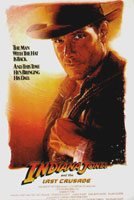






|
|

 |
1. INTRODUCTION
|
|

|
|
Although it had been four years since the release of Indiana
Jones and the Temple of Doom, Steven Spielberg was determined
to direct a grand finale for the series, partly to counter
the hostile reaction the previous film had recieved from critics
and many moviegoers as well. Although it had been a box office
smash, there was a general feeling of disillusionment with
the final cut. Reflecting on the second Indy adventure, Spielberg
would later admit, "I wasn't happy with that film at
all. It was too dark, too subterranean, and much too horrific...
There is not an ounce of my personal feeling in it."
Ford would admit to having the same opinion, saying he felt
it was excessive in its brutality.
|
| The hook which the filmmakers decided upon
the differentiate this movie from the predecessors would be
the introduction of Indy's father, a famous, eccentric archaeologist
named Professor Henry Jones. The plot would center on Indy and
his dad engaged in a life-and-death struggle with the Nazis
to locate the sacred Holy Grail, the cup from which Jesus allegedly
drank during the Last Supper. The story line suggested by Adolf
Hitler's well-known belief in the supernatural, as well as his
quest for immortality. As legend holds that the person who drinks
from the Grail lives forever, it would seem only natural that
the Führer would embark on a relentless pursuit of the
sacred cup. In Jeffrey Boam's script, Indy's father is a man
who has devoted his entire adult life to locating the Grail.
Ironically, he has been captured by the Nazis just as he has
finally learned its location and is being forced to lead the
Gestapo to its hiding place. The elder Jones manages to get
word to his estranged son Indiana, and the two men narrowly
defeat the forces of the Third Reich while simultaneously learning
to respect and love each other for the first time in their lives |
|
Most of the filmmakers who worked on the first and second
motion picture adventures of Indiana Jones reunited to make
"Indiana Jones and the Last Crusade." They include composer
John Williams, cinematographer Douglas Slocombe, editor Michael
Kahn, production designer Elliot Scott, costume designer Anthony
Powell, special effects supervisor George Gibbs, and stunt
Coordinator Vic Armstrong. Visual Effects were again produced
at Industrial Light & Magic; and the sound designed at Sprocket
Systems. In 1982 "Raiders of the Lost Ark" was nominated for
eight Academy Awards, including Best Picture and Best Director;
and won Oscars for art direction, sound, film editing, visual
effects, and a special achievement award for sound effects
editing.
"Everybody involved was well aware that there may not be
another Indiana Jones movie. But I don't think that so much
created a different mindset as it inspired us to think that,
if this were to be the last one, let's make this a great one
to go out on.
|
|
|


